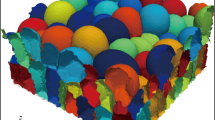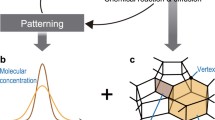Abstract
Tissue morphogenesis in multicellular organisms is accompanied by proliferative cell behaviors: cell division (increase in cell number after each cell cycle) and cell growth (increase in cell volume during each cell cycle). These proliferative cell behaviors can be regulated by multicellular dynamics to achieve proper tissue sizes and shapes in three-dimensional (3D) space. To analyze multicellular dynamics, a reversible network reconnection (RNR) model has been suggested, in which each cell shape is expressed by a single polyhedron. In this study, to apply the RNR model to simulate tissue morphogenesis involving proliferative cell behaviors, we model cell proliferation based on a RNR model framework. In this model, cell division was expressed by dividing a polyhedron at a planar surface for which cell division behaviors were characterized by three quantities: timing, intracellular position, and normal direction of the dividing plane. In addition, cell growth was expressed by volume growth as a function of individual cell times within their respective cell cycles. Numerical simulations using the proposed model showed that tissues grew during successive cell divisions with several cell cycle times. During these processes, the cell number in tissues increased while maintaining individual cell size and shape. Furthermore, tissue morphology dramatically changed based on different regulations of cell division directions. Thus, the proposed model successfully provided a basis for expressing proliferative cell behaviors during morphogenesis based on a RNR model framework.





Similar content being viewed by others
References
Baena-López LA, Baonza A et al (2005) The orientation of cell divisions determines the shape of Drosophila organs. Curr Biol 15(18):1640–1644
Davies JA (2005) Mechanisms of morphogenesis: the creation of biological form. Elsevier, Burlingto
Eiraku M, Adachi T et al (2012) Relaxation-expansion model for self-driven retinal morphogenesis. Bioessays 34(1):17–25
Eiraku M, Takata N et al (2011) Self-organizing optic-cup morphogenesis in three-dimensional culture. Nature 472(7341):51–56
Farhadifar R, Röper JC et al (2007) The influence of cell mechanics, cell-cell interactions, and proliferation on epithelial packing. Curr Biol 17(24):2095–2104
Friedlander DR, Mège RM et al (1989) Cell sorting-out is modulated by both the specificity and amount of different cell-adhesion molecules (CAMs) expressed on cell-surfaces. Proc Natl Acad Sci USA 86(18):7043–7047
Gibson WT, Veldhuis JH et al (2011) Control of the mitotic cleavage plane by local epithelial topology. Cell 144(3):427–438
Gong Y, Fraser C, Mo SE (2004) Planar cell polarity signalling controls cell division orientation during zebrafish gastrulation. Nature 430:689–693
Heisenberg CP, Tada M et al (2000) Silberblick/Wnt11 mediates convergent extension movements during zebrafish gastrulation. Nature 405:76–81
Honda H, Yamanaka H (1984) A computer simulation of geometrical configurations during cell division. J Theor Biol 106(3):423–435
Honda H, Motosugi N et al (2008) Computer simulation of emerging asymmetry in the mouse blastocyst. Development 135(8):1407–1414
Honda H, Nagai T et al (2008) Two different mechanisms of planar cell intercalation leading to tissue elongation. Dev Dyn 237(7):1826–1836
Honda H, Tanemura M et al (2004) A three-dimensional vertex dynamics cell model of space-filling polyhedra simulating cell behavior in a cell aggregate. J Theor Biol 226(4):439–453
Ingber DE, Mammoto T (2010) Mechanical control of tissue and organ development. Development 137(9):1407–1420
Lechler T, Fuchs E (2005) Asymmetric cell divisions promote stratification and differentiation of mammalian skin. Nature 437(7056):275–280
Lecuit T, Lenne PF (2007) Cell surface mechanics and the control of cell shape, tissue patterns and morphogenesis. Nat Rev Mol Cell Biol 8(8):633–644
Lecuit T, Rauzi M et al (2008) Nature and anisotropy of cortical forces orienting Drosophila tissue morphogenesis. Nat Cell Biol 10(12): 1401–1410
Lecuit T, Rauzi M et al (2010) Planar polarized actomyosin contractile flows control epithelial junction remodelling. Nature 468(7327):1110–1114
Noguchi H, Gompper G (2005) Dynamics of fluid vesicles in shear flow: effect of membrane viscosity and thermal fluctuations. Phys Rev E 72(1):11901–11914
Okuda S, Inoue Y et al. (2012) Reversible network reconnection model for simulating large deformation in dynamic tissue morphogenesis. Biomech Model Mechanobiol. doi:10.1007/s10237-012-0430-7
Rauzi M, Verant P et al (2008) Nature and anisotropy of cortical forces orienting Drosophila tissue morphogenesis. Nat Cell Biol 10(12):1401–1410
Reddy GV, Heisler MG et al (2004) Real-time lineage analysis reveals oriented cell divisions associated with morphogenesis at the shoot apex of Arabidopsis thaliana. Development 131:4225–4237
Staple DB, Farhadifar R et al (2010) Mechanics and remodelling of cell packings in epithelia. Eur Phys J E Soft Matter 33(2):117–127
Ujihara Y, Nakamura M et al (2005) Proposed spring network cell model based on a minimum energy concept. Ann Biomed Eng 38(4):1530–1538
Poulson ND, Lechler T (2010) Robust control of mitotic spindle orientation in the developing epidermis. J Cell Biol 191(5):915–922
Shraiman BI (2005) Mechanical feedback as a possible regulator of tissue growth. Proc Natl Acad Sci USA 102(9):3318–3323
Siller KH, Cabernard C et al (2006) The NuMA-related Mud protein binds Pins and regulates spindle orientation in Drosophila neuroblasts. Nat Cell Biol 8(6):594–600
Taniguchi K, Maeda R et al (2011) Chirality in planar cell shape contributes to left-right asymmetric epithelial morphogenesis. Science 333(6040):339–341
Weliky M, Oster G (1990) The mechanical basis of cell rearrangement. 1. Epithelial morphogenesis during fundulus epiboly. Development 109(2):373–386
Woolner S, Papalopulu N (2012) Spindle position in symmetric cell divisions during epiboly is controlled by opposing and dynamic apicobasal forces. Dev Cell 22(4):775–787
Acknowledgments
This work was partially supported by the Funding Program for Next Generation World-Leading Researchers (LR017) from the Ministry of Education, Culture, Sports, Science and Technology (MEXT) in Japan. Satoru Okuda was supported by the Japan Society for the Promotion of Science (JSPS) as a JSPS fellow. Yasuhiro Inoue was supported by “Morphologic” Grant-in-Aid for Scientific Research on Innovative Areas (23127506) from the MEXT in Japan.
Author information
Authors and Affiliations
Corresponding author
Electronic supplementary material
Rights and permissions
About this article
Cite this article
Okuda, S., Inoue, Y., Eiraku, M. et al. Modeling cell proliferation for simulating three-dimensional tissue morphogenesis based on a reversible network reconnection framework. Biomech Model Mechanobiol 12, 987–996 (2013). https://doi.org/10.1007/s10237-012-0458-8
Received:
Accepted:
Published:
Issue Date:
DOI: https://doi.org/10.1007/s10237-012-0458-8




